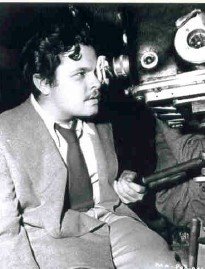 Since July 4th - Independence Day - is now upon us, it seems quite right that Turner Classic Movies is marking the holiday with a celebration of the independent filmmaker and his filmic tradition. Edge of Outside is the network's first fully in-house produced documentary, and this enjoyable, fast-paced effort premieres tomorrow night (July 5th) at 8:00 pm. Directed by Shannon Davis, this enterprise is eminently worthy of viewing attention, especially if you love film - and in particular, film history.
Since July 4th - Independence Day - is now upon us, it seems quite right that Turner Classic Movies is marking the holiday with a celebration of the independent filmmaker and his filmic tradition. Edge of Outside is the network's first fully in-house produced documentary, and this enjoyable, fast-paced effort premieres tomorrow night (July 5th) at 8:00 pm. Directed by Shannon Davis, this enterprise is eminently worthy of viewing attention, especially if you love film - and in particular, film history.Edge of Outside defines "independence" quite broadly, which simply means that director Davis seizes the opportunity to discuss with today's finest filmmakers such legendary talents as Samuel Fuller and Nicholas Ray, as well as Stanley Kubrick, Orson Welles and John Cassavetes. Since the definition of independent is quite liberal here, the examined movie maker doesn't even necessarily need to work outside the studio system to be considered for inclusion. He just needs to understand how to manipulate the system so as to bring his unique personality and artistry to a celluloid project.
Even the Master of Suspense, Alfred Hitchcock, is gazed upon in terms of his "independent" streak here. And if there's a downside at all to this interesting TV documentary, that's probably it: some film scholars will no doubt quibble with the filmmaker selections. For instance, other than Roger Corman, no horror movie makers are discussed in Edge of Outside. For quite a long a time, John Carpenter's Halloween and George Romero's Dawn of the Dead were the highest grossing independent films of all time. That might merit a mention at least. Also - no women filmmakers are highlighted in this production. No Jane Campion or Mira Nair to be found anywhere...and that feels like an omission. Also, let's face it, a strong case could be made that George Lucas was an independent filmmaker, at least regarding the original Star Wars. True, his movie became a blockbuster immediately, but that doesn't change the fact that he accomplished his personal vision while facing enormous stress and adversity. This is where, perhaps, a more narrow reading of the term "independent" might have benefited Edge of Outside.
But no matter. The strong value of this loosely-structured documentary arises from the wonderful on-camera interviews. Martin Scorsese, Spike Lee, Arthur Penn, John Sayles, Peter Bogdanovich, Ed Burns, Gena Rowlands, Darren Aronofsky and the like discuss the reasons they admire and cherish Woody Allen, John Cassavetes ("the standard bearer" for independence), Samuel Fuller ("the greatest unknown director in the world") and "Bloody Sam" Peckinpah. Any network program that acknowledges and cherishes Cassavetes, perhaps the most authentic filmmaker in cinema history, wins major points with me. Basically, this documentary is like enrolling in a film study class with high-profile director lecturers. Each interview will hold your rapt attention.
One of my favorite moments in the documentary highlights Orson Welles' adage that "accidents are the friends" of a director, as well as his explanation about "dream sequences" freeing a crew from the trap of conventional logic. When in archival footage Welles notes how two percent of film is "movie making" and 98% is hustling, you realize again what kind of craziness this brilliant talent contended with. I also enjoyed the discussion of low budgets, and that they can actually be a strength. Welles said that "the enemy of art is the absence of limitations." That one line better sums up Hollywood in the CG era than just about anything I've read or heard elsewhere. It is very, very true, and I'm glad it is featured here.
Buttressed with clips from classic movies like Rebel Without a Cause, The Getaway, Citizen Kane, Touch of Evil, 2001: A Space Odyssey, Lolita and more, Edge of Outside is like a survey of your favorite movie makers, and the documentary will remind you again about all the films you want to return to and sample. Personally, I'm motivated to queue up a Cassavetes marathon and then go back and re-examine the French New Wave. I've always been a huge Truffaut fan (and I watched The Four Hundred Blows again recently...) so it will be fun to return to his work (and Godard's) in light of the points made in the documentary.
According to the documentary, independent filmmakers are "born out of conflict," evade "lucrative traps" and "haven't seen the sun in ten years." They are "self-destructive" and can see outside "the hierarchy of the moment." Those are mostly good descriptors, and a fine place to begin a discussion of independent filmmakers.
Accordingly, TCM is following up the airing of the documentary with a month-long tribute to filmmakers who have worked on the fringe of Hollywood. In fact, at 9:15 pm on Wednesday night, immediately following Edge of Outside, TCM airs John Cassavetes' 1968 masterpiece, Faces. The following Wednesday, (July 12) films by Charles Chaplin, Erich Von Stroheim, Frank Capra and Orson Welles are featured. On Wednesday July 19, Nicholas Ray, Kubrick, Fuller and Peckinpah fill out the slate.
So here it is: let Edge of Outside serve as your informative overview and primer for a month of great independent movies. I guess the TiVo will be working overtime at the Muir house this July...







Me too! This review came just in time for me to catch this cool doc. Unfortunately, Cassavetes' "Faces" followed it up and I wasted a good hour of my life. You can read my jaded reaction over at my blog.
ReplyDeleteI am such a freaking PHILISTINE!